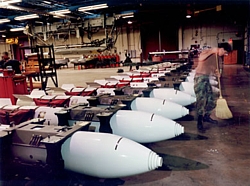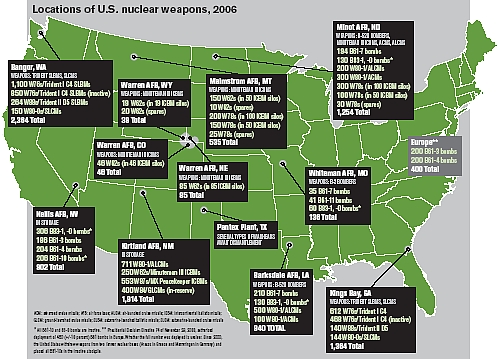 |
| B83 thermonuclear bombs at Barksdale Air Force Base, Louisiana. Image © Paul Shambroom |
Ever wondered where all those nukes are stored?
A new review published in the November/December issue of the Bulletin of the Atomic Scientists shows that the United States stores its nearly 10,000 nuclear warheads at 18 locations in 12 states and six European countries.
The article’s authors – Hans M. Kristensen of the Federation of American Scientists and Robert S. Norris of the Natural Resources Defense Council – identified the likely locations by piecing together information from years of monitoring declassified documents, officials statements, news reports, leaks, conversations with current and former officials, and commercial high-resolution satellite photos.
The highest concentration of nuclear warheads is at the Strategic Weapons Facility Pacific in Bangor, Washington, which is home to more than 2,300 warheads – probably the most nuclear weapons at any one site in the world. At any given moment, nearly half of these warheads are on board ballistic-missile submarines in the Pacific Ocean.
Approximately 1,700 warheads are deployed on Ohio-class ballistic missile submarines operating in the Pacific and Atlantic oceans, and about 400 warheads are at eight bases in six European countries – Belgium, Germany, Italy, the Netherlands, Turkey and Great Britain (for more information on U.S. warheads in Europe, go to http://www.nukestrat.com/us/afn/nato.htm). The United States is the only nuclear weapon state that deploys nuclear weapons in foreign countries.
Consolidation of U.S. nuclear storage sites has slowed considerably over the past decade compared to the period between 1992 and 1997, when the Pentagon withdrew nuclear weapons from 10 states and numerous European bases. Over the past decade, the United States removed nuclear weapons from three states – California, Virginia and South Dakota, and from one European country – Greece.
The overview finds that more than two-thirds of all U.S. nuclear warheads are still stored at bases for operational ballistic missiles and bombers, even through the Cold War ended more than 16 years ago. More than 2,000 of those warheads are on high alert, ready to launch on short notice. Only about 28 percent of U.S. warheads have been moved to separate storage facilities. The largest of these, an underground vault at Kirtland Air Force Base in Albuquerque, New Mexico, stores more than 1,900 warheads.
The 10 U.S. sites that currently host nuclear weapons are: the Strategic Weapons Facility Pacific, Bangor, Washington; Nellis Air Force Base, Nevada; Warren Air Force Base, Wyoming; Kirtland Air Force Base, New Mexico; Malmstrom Air Force Base, Montana; Minot Air Force Base, North Dakota; Pantex Plant, Texas; Barksdale Air Force Base, Louisiana; Whiteman Air Force Base, Missouri; and the Strategic Weapons Facility Atlantic, Kings Bay, Georgia. (See map.)
 |
|
Full-size map available here. Full article available from Bulletin of the Atomic Scientists here. |
Go on a Nuclear Google Trip
Based on the information in the Bulletin article, FAS and NRDC have created a virtual satellite image tour of the 18 nuclear weapons storage facilities in the United States and Europe. To take the tour you need to have GoogleEarth installed on your computer. (GoogleEarth is available for free here.) Once you’re set up, click here or on the link below the Google map below to begin. When GoogleEarth has finished loading, check the “Where the Bombs are, 2006” box in the “Places” window to the left to activate the placemarks, click once on a placemark to get an overview of the nuclear weapons stored at the base, and click twice to zoom in on the facility.
The U.S. government refuses to disclose where it stores nuclear weapons, but the researchers emphasize that all the locations have been known for years to house nuclear weapons. Safety of nuclear weapons is determined not by knowledge of their location but by the military’s physical protection of the facilities and that the weapons cannot be detonated by unauthorized personnel.
Background: Where the Bombs are, 2006 | Status of World Nuclear Forces
The FY2026 National Defense Authorization Act (NDAA) paints a picture of a Congress that is working to both protect and accelerate nuclear modernization programs while simultaneously lacking trust in the Pentagon and the Department of Energy to execute them.
While advanced Chinese language proficiency and cultural familiarity remain irreplaceable skills, they are neither necessary nor sufficient for successful open-source analysis on China’s nuclear forces.
Satellite imagery has long served as a tool for observing on-the-ground activity worldwide, and offers especially valuable insights into the operation, development, and physical features related to nuclear technology.
This report outlines a framework relying on “Cooperative Technical Means” for effective arms control verification based on remote sensing, avoiding on-site inspections but maintaining a level of transparency that allows for immediate detection of changes in nuclear posture or a significant build-up above agreed limits.
